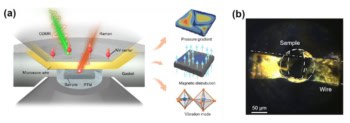Japanese physicists have demonstrated for the first time that iron becomes a superconductor under high pressure. Iron loses its strong ferromagnetism - which usually destroys superconductivity - at pressures around 15 gigapascals. Katsuya Shimizu and colleagues at Osaka University showed that compressed iron superconducts at temperatures below 2 kelvin. The team also detected the Meissner effect, another signature of superconductivity, in iron (K Shimizu et al 2001 Nature 412 316).
Magnetism has long been thought to be incompatible with superconductivity. According to the Bardeen-Cooper-Schreiffer theory of superconductivity, electrons with opposite spins pair up and are propelled through the superconductor by vibrations of the crystal lattice known as phonons. But magnetism changes the spin on the electrons and stops them pairing up. Even a very small number of magnetic impurities can inhibit the formation of pairs. In order to superconduct, iron – which is strongly ferromagnetic – must therefore overcome this effect.
Iron has a body-centred cubic structure under ambient conditions, which gives rise to its ferromagnetism. Under high pressures, however, it transforms to hexagonal close packing structure, in which ferromagnetism is not thought to exist. This raises the possibility that iron could become a superconductor, as first predicted in 1979.
To investigate, Shimizu and colleagues placed an iron chip just tens of microns across and about 100 microns long inside a pressure cell made of diamond. The sample was compressed and then chilled with a helium refrigerator. The team measured the resistivity of the chip between 10 kelvin and 30 millikelvin for a range of pressures.
The resistivity of the iron sample fell sharply when the pressure reached 15 gigapascals – over ten thousand times greater than atmospheric pressure – close to absolute zero. Shimizu and co-workers found that this transition temperature rose to 2 kelvin at a pressure of 21 gigapascals, but dropped again at higher pressures.
SQUID measurements of magnetic flux also revealed that the iron expelled magnetic flux from its interior. This phenomenon – known as the Meissner effect – is a characteristic of diamagnetic superconductors, and suggests that iron may be weakly magnetic under extreme pressure.
Elsewhere, recent studies have shown that some ‘organic metals’ can superconduct inside a strong magnetic field under certain circumstances. Together with these results, the findings of Shimizu and colleagues will help physicists to understand the mechanisms that underpin superconductivity. Insights into how pressure affects the structure of iron could also shed light on the properties of the highly compressed iron that makes up the Earth’s core.



